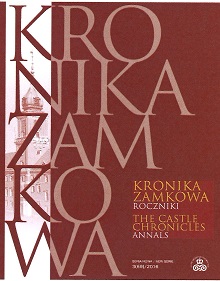Portret konny Zygmunta III w Weimarze : nieznany rysunek przygotowawczy do ryciny Wolfganga Kiliana.
The equestrian portrait of Zygmunt III in Weimar. An unknown prepatory drawing for Wolfgang Kilian's engraving.
Author(s): Jacek ŻukowskiSubject(s): Fine Arts / Performing Arts, History of Art
Published by: Arx Regia® Wydawnictwo Zamku Królewskiego w Warszawie – Muzeum
Keywords: Foreign Committee for the Reconstruction of the Royal Castle in Warsaw – reconstruction; press; and pro-Poland milieu abroad; Horyzonty; Kronika; Naprzód; The Federation of Poles in Great Britain;
Summary/Abstract: The discovery of the portrait of Zygmunt III in the Duchess Anna Amalia Library in Weimar prompted the author to draft a preliminary monograph about this work of art which would open up an opportunity for further academic research on the subject, since the history of the portrait before 1840 is still waiting to be uncovered. This article give readers an opportunity to familiarize themselves with the vagaries of visual court propaganda (in this case, the portrait of Zygmunt III), in particular the practice of commissioning likenesses of kings from artists abroad, and with the works of art also being used by their nineteenth- century owners to facilitate the process of teaching about art and connoisseurship (Schorn, Liphart). The drawing—carefully executed, both with regards to the contours and the compositional elements— was prepared as a model for an engraving by Wolfgang Kilian, published in Augsburg at the turn of1609 and 1610. Although little known, the engraving is particularly important in the artist’s career. The composition of the drawing was conceived by Tommaso Dolabella, who sent guidelines from Kraków, together with compositional drawings which, for the most part, were largely based on works by Stradanus and Antonio Tempesta, while claiming the authorship of the prototype for himself. Kilian’s circle of co- workers included the painter and engraver, A.L. Schärer, but the actual surname of the author of the equestrian portrait, who used the initials ALS, is yet to be determined (the signature Tobias Stimmer is a falsification). The unknown artist was a master of high-calibre wash drawings which although multi- shaded, maintained distinct outlines—a sixteenth-century practice which placed him in north-European circles, most probably in the southern Netherlands. The portrait was commissioned long before Zygmunt III’s recapture of Smoleńsk in 1611, which is alluded to in the background. It was intended for the European viewer and its message was based on the idea of a Liberator (regaining lands occupied by the Grand Duchy of Muscovy), but above all, that of a Guardian, a protector, ensuring freedom and peace to his future subjects (i.e. Muscovite— because Zygmunt III aspired to be the Grand Duke of Muscovy). The engraving plate sent from Augsburg was transformed under Dolabella’s watchful eye. Several other canvases were later modelled on the engraving—one of which is to be found in the collections in Wawel Castle in Kraków, while another copy adorned the Audience Chamber at the Royal Castle in Warsaw. Another version of the engraving was then published in Kraków, under the name of Dolabella, which was a travesty of Kilian’s version. It was far-removed from reality and adapted for the needs of local propaganda.
Journal: Kronika Zamkowa. Roczniki
- Issue Year: 3/2016
- Issue No: 3
- Page Range: 7-58
- Page Count: 52
- Language: Polish

